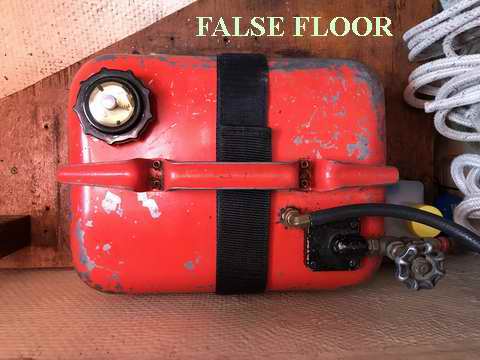| SJ23 Tech Tip D02, (Updated 2015-11-31) Bob Schimmel | |||
|
Gas Tank in the Port Locker - No fumes in the cockpit. |
|||
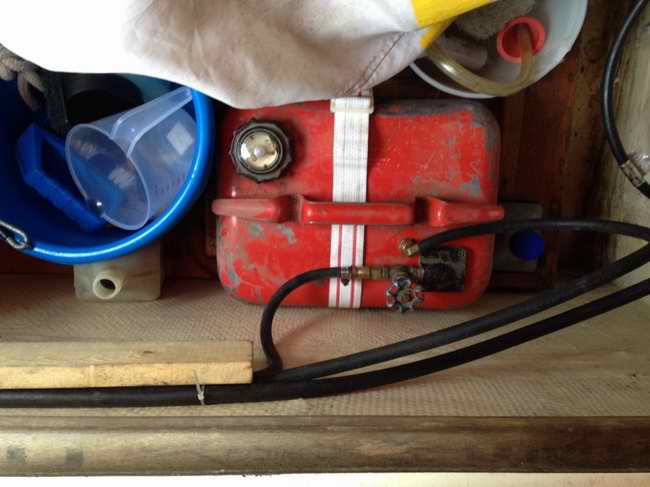 I
hate breathing gas fumes while sitting in the cockpit. They stay trapped where they turn my stomach into a
jelly mass. This takes away from the ambience a bit, don't you think? The fumes are more prevalent in hot weather
when the sun bakes the tank till the vent releases its vial content. While
a portable gas tank sitting at the aft of the cockpit might be considered
out of the way, I don't like the floor space it takes, the extra weight
back there and the fact that it covers both drains. Housing
the tank in the port locker has many advantages; I
hate breathing gas fumes while sitting in the cockpit. They stay trapped where they turn my stomach into a
jelly mass. This takes away from the ambience a bit, don't you think? The fumes are more prevalent in hot weather
when the sun bakes the tank till the vent releases its vial content. While
a portable gas tank sitting at the aft of the cockpit might be considered
out of the way, I don't like the floor space it takes, the extra weight
back there and the fact that it covers both drains. Housing
the tank in the port locker has many advantages;
When I bought Panache the 2.5 US gallon tank shown below was located inside the port locker but it did not have an external vent. This configuration was actually in compliance with the US Coast Guard regulation as stated on the safety warning label on the underside of the locker lid. Really!! And so many people smoked back then!
NOTE - IIRC, the US Coast Guard regulations on fuel storage ventilation, did not apply until some time in 1980. If your boat was manufactured prior to this date then storing the tank in the locker may still be legal. However, the new regulation likely replaces the old one and besides, what possible reason could you have to keep from upgrading to a safer configuration?
WARNING - Gasoline fumes are highly flammable. Under certain conditions, they ARE heavier than air and extremely explosive. Therefore, if you store your gas tank in the port cockpit locker, the tank MUST be vented to the outside of the hull through an approved hose that goes through a vapour tight bulkhead fitting, sealed at the hull. In addition, NEVER fill the tank above the "safe fill level" to allow for expansion. This is commonly defined as not more than 90% for a portable tank. Don't rely on the fuel gauge as it isn't accurate enough. Use a dip stick. CONSTRUCTION - Panache's gas tank
is secured to a flat floor that I previously fabricated for the port locker (Tech
Tip B03). The floor works like a charm. The
fiddles on the false floor were fastened snug around the perimeter of the
tank and the tank is held tight to the floor with a 2" wide Velcro strap. It is imperative
that the tank is secured. The 2.5 US gallon portable tank shown below was not equipped with an
external vent fitting so I installed a right angle brass
fitting through the top of the tank. It is located within finger reach of the
gas line fitting (temporarily removed to install the vent) so I could tighten the nut on the inside with a wrench.
The fitting is sealed with
a gasoline rated gasket
for a gas tight seal.
NOTE: DO NOT install a bulkhead fitting through the transom to pass the fuel line. You run the risk of leaking explosive gasoline fumes inside the hull without knowing it, should the connector come loose. Always use a continuous hose from the tank to the outboard and support it for its full length.
On Panache the gasoline, tank vent and propane hoses are supported on a continuous sloped wood trough so water can't be trapped in a sag to block flow. The trough is made from a wood hockey stick handle and an equal length of wider spruce screwed to the inside wall of the port locker, near the top of the locker. Together they create a channel about 1" wide and 1.5" deep. See sketch above and photo below. The hoses rest there, fully protected and supported without flex. The hoses are also secured in the trough with tie wraps to prevent them from popping out. Securing the hoses became necessary when I added a third hose going to the propane locker on the transom. You might think it a foolhardy installation to mix propane and gasoline but a hose that is protected and secured inside a trough is infinitely superior to one getting beat up at the bottom of a locker full of loose gear. No support is required between the aft end of the trough and the transom. The gap is very short. However, the gasoline hose is supported across the transom with a rubber lined clamp at the top gudgeon bolts as shown at left. This trough and the hoses in it are serviceable on the water. CONCLUSION - Is it ever nice to breathe fresh air in the cockpit when the tank is vented outside the hull. It was immediately obvious that this installation worked but it took several weeks to rid the cabin of lingering gasoline smell. I can now sleep at night. After the tank was vented outside I have never smelled gas fumes in the cabin or cockpit, regardless of the direction of the wind. Fact is, I never smell gasoline fumes around the vent so the cool locker is doing its job as well. The security while sailing in rough weather with the tank tied down cannot be overstated.
In 2018 I abandoned my large 5 US gallon tank after using it for seven years. It blocked my access to inspect the drain hoses under the cockpit and I could not lift the tank out of the locker without first removing the fittings from it. This was a self defeating and time consuming job. It is more important to inspect those hoses than to have a long motoring range. So I reverted to my 2.5 US gal tank shown here and added an inline fuel filter (just out of camera view). When I have to extend my motoring range I will siphon mixed fuel from a jug using a shaker hose, all without spilling a drop. The portable gas jug in the cool locker has never vented fumes. It is pressure rated and since fuel can't slop around in a full jug it keeps venting to minimum. If it does vent, I'll park it on deck somewhere with the cap tightened to keep water out. This is something to consider if you have to carry extra fuel for a long transit, especially in lumpy water. In that situation it may be safer to strap the jug to the shrouds (NOT during an electrical storm) or leave it in the cockpit. SAFETY NOTES:
|
|||
|
Return to Tech Tip Index. . . . . . . . . . . . . . . Have a Question? |
|||
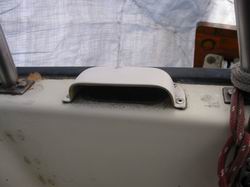 The only saving grace
on Panache to remove gas fumes from the port locker are
two transom mounted air scoops that
provide passive ventilation. On pointed forward and the other aft. I think the second owner installed them for
this reason. While these
vents do an OK job of venting the locker, they
CANNOT evacuate heavier than air gasoline fumes, hence the hidden hazard.
The only saving grace
on Panache to remove gas fumes from the port locker are
two transom mounted air scoops that
provide passive ventilation. On pointed forward and the other aft. I think the second owner installed them for
this reason. While these
vents do an OK job of venting the locker, they
CANNOT evacuate heavier than air gasoline fumes, hence the hidden hazard.
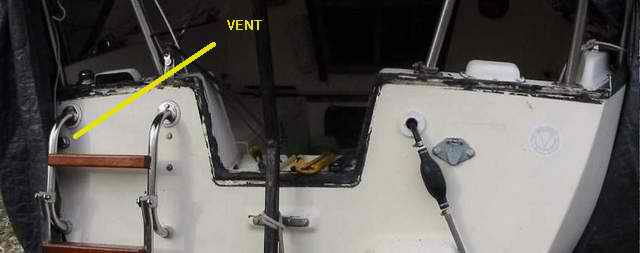 FUEL VENT - This thru hull vent is
manufactured by Outboard Marine Corp (OMC) and is equipped with a flame
arresting wire mesh. It is installed high up on the
port transom to keep water out and behind the boarding ladder for
protection. The vent holes are pointed down to
keep rain, dew
and snow out. The vent hose is pushed over the barbed fitting and secured with a hose clamp. I used 1/4" ID gasoline approved fuel hose between the fuel vent and
the tank. You can just see the vent in the photo above.
FUEL VENT - This thru hull vent is
manufactured by Outboard Marine Corp (OMC) and is equipped with a flame
arresting wire mesh. It is installed high up on the
port transom to keep water out and behind the boarding ladder for
protection. The vent holes are pointed down to
keep rain, dew
and snow out. The vent hose is pushed over the barbed fitting and secured with a hose clamp. I used 1/4" ID gasoline approved fuel hose between the fuel vent and
the tank. You can just see the vent in the photo above.
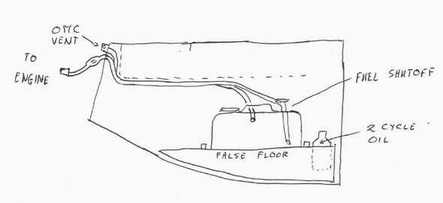 SUPPORT FOR FUEL LINE - The fuel line is continuous to prevent a leak from a loose connector.
It is fed through the transom via a
nylon through hull fitting installed high on the starboard transom
(shown above). This is close to the outboard where it is
convenient to pump up
the line pressure to start the outboard.
SUPPORT FOR FUEL LINE - The fuel line is continuous to prevent a leak from a loose connector.
It is fed through the transom via a
nylon through hull fitting installed high on the starboard transom
(shown above). This is close to the outboard where it is
convenient to pump up
the line pressure to start the outboard. 